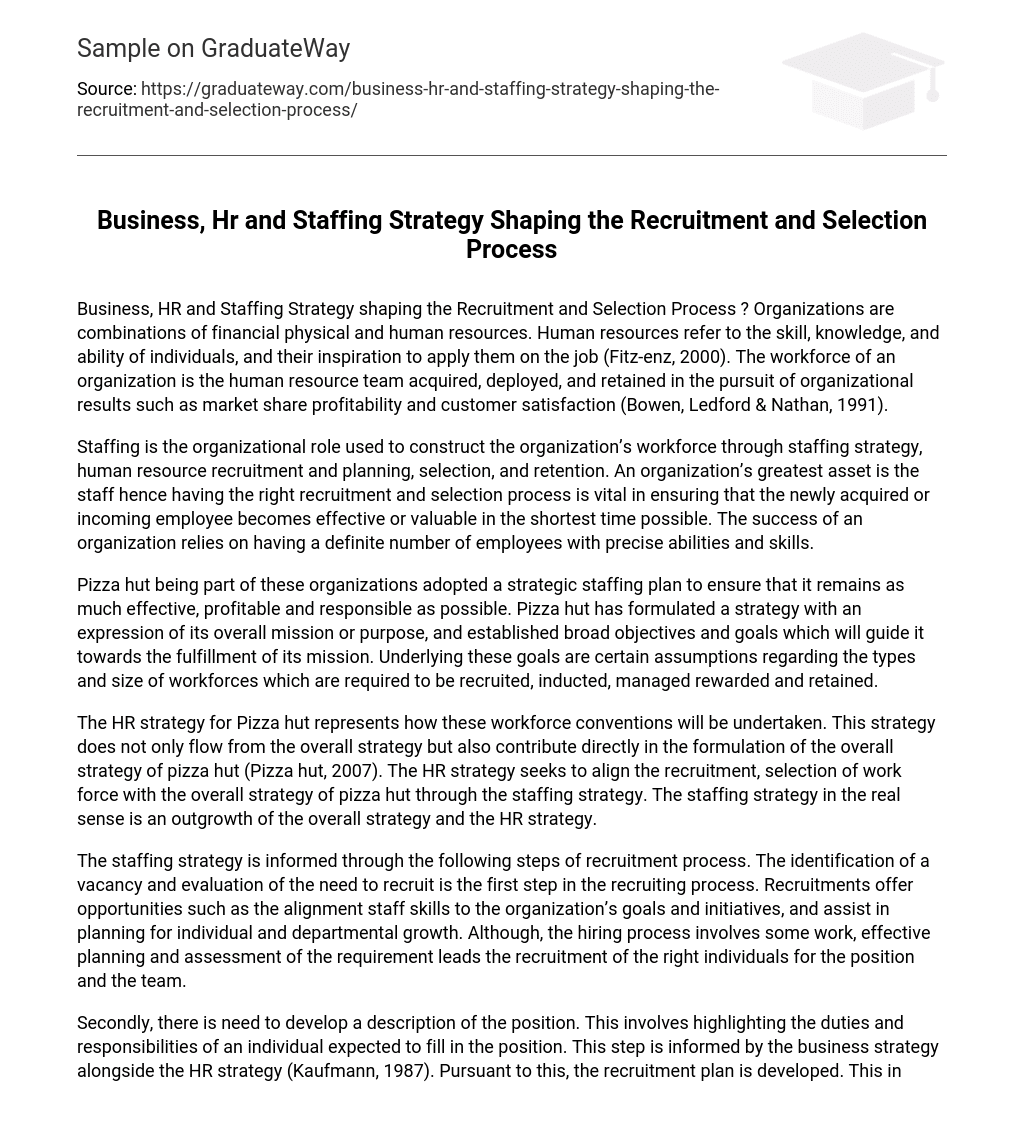Business, HR and Staffing Strategy shaping the Recruitment and Selection Process ? Organizations are combinations of financial physical and human resources. Human resources refer to the skill, knowledge, and ability of individuals, and their inspiration to apply them on the job (Fitz-enz, 2000). The workforce of an organization is the human resource team acquired, deployed, and retained in the pursuit of organizational results such as market share profitability and customer satisfaction (Bowen, Ledford & Nathan, 1991).
Staffing is the organizational role used to construct the organization’s workforce through staffing strategy, human resource recruitment and planning, selection, and retention. An organization’s greatest asset is the staff hence having the right recruitment and selection process is vital in ensuring that the newly acquired or incoming employee becomes effective or valuable in the shortest time possible. The success of an organization relies on having a definite number of employees with precise abilities and skills.
Pizza hut being part of these organizations adopted a strategic staffing plan to ensure that it remains as much effective, profitable and responsible as possible. Pizza hut has formulated a strategy with an expression of its overall mission or purpose, and established broad objectives and goals which will guide it towards the fulfillment of its mission. Underlying these goals are certain assumptions regarding the types and size of workforces which are required to be recruited, inducted, managed rewarded and retained.
The HR strategy for Pizza hut represents how these workforce conventions will be undertaken. This strategy does not only flow from the overall strategy but also contribute directly in the formulation of the overall strategy of pizza hut (Pizza hut, 2007). The HR strategy seeks to align the recruitment, selection of work force with the overall strategy of pizza hut through the staffing strategy. The staffing strategy in the real sense is an outgrowth of the overall strategy and the HR strategy.
The staffing strategy is informed through the following steps of recruitment process. The identification of a vacancy and evaluation of the need to recruit is the first step in the recruiting process. Recruitments offer opportunities such as the alignment staff skills to the organization’s goals and initiatives, and assist in planning for individual and departmental growth. Although, the hiring process involves some work, effective planning and assessment of the requirement leads the recruitment of the right individuals for the position and the team.
Secondly, there is need to develop a description of the position. This involves highlighting the duties and responsibilities of an individual expected to fill in the position. This step is informed by the business strategy alongside the HR strategy (Kaufmann, 1987). Pursuant to this, the recruitment plan is developed. This involves the mapping of a well-structured strategy of attracting and recruiting the best qualified individuals and ensuring that the pool of applicants is well represented.
This development of this strategy involves the recognition of the necessary advertising channels to be used to achieve those goals. The next stage involves the composition of the selection committee and the implementation of the recruitment plan. This involves the advertisement of the positions, the talent sourcing and outreach activities. Upon posting of advertisements and talent search activities, the selection plan scrutinizes the applicants to come up with the short listed individuals who are invited for are interview.
The interviewing process being informed by the business and HR strategy is implemented with an aim of recruiting the best and most valuable individuals who can best contribute to the business goals(Kaufmann, 1987). The strategic decision to recruit new employees from the ranks of experienced people at other organizations as well as recruiting fresh and energetic individuals may lead the organization to develop very active, personalized, and secret recruiting processes for luring these people away. It may also lead to the development of special selection methods for assessing job experiences and accomplishments.
In such ways, the Business, HR and Staffing strategy shape the recruitment and selection process. References Bowen, D. E. , Ledford, G. E. , & Nathan, B. R. (1991). Hiring for the Organization and Not the Job. Academy of Management Executive, 5(4), pp. 35–51. Fitz-enz, J. (2000). The ROI of Human Capital. New York: Amacom. Kaufmann, P. J. (1987). Pizza Hut, Inc. Harvard Business School Cases, 1. Pizza hut (2007). Pizza Hut: Information pack. Retrieved April 23, 2013 from http://www. pizzahut. co. uk/assets/redroof/files/Student_Pack. pdf





